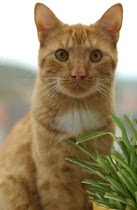Sunday, June 14, 2009
Watch Out for those Toxic Yard Plants
Did you know? That plants commonly found in yards, such as Azalea, can be toxic — and even deadly — to pets if ingested.
According to a recent MSNBC online article entitled 10 of the Most Toxic Plants to Pets,a veterinarian states, “A rule of thumb is that the prettier it is, the more likely it is to be toxic,” says Dr. Sharon Gwaltney-Brant, a veterinarian and board-certified toxicologist who is vice president of the Animal Poison Control Center, based in Urbana, Ill.
According to that same article the 10 top toxic plants are:
Lilies
Members of the Lilium spp. are highly toxic to cats. Ingestion of even very small amounts of any part of the plant can result in severe kidney damage.
Sago Palm
Also known as the cycad palm, all parts of Cycas Revoluta are poisonous, in particular the seeds or “nuts.” Just one or two seeds can cause vomiting, diarrhea, depression, seizures and liver failure.
Autumn Crocus
Ingestion of Colchicum autumnale can result in oral irritation, bloody vomiting, diarrhea, shock, multi-organ damage and bone marrow suppression.
Azalea/Rhododendron
Members of the Rhododendron spp. contain cardio toxins that may produce vomiting, drooling, diarrhea, weakness, depression of the central nervous system in animals and potentially coma and death. More refined, or domesticated, azaleas and rhododendrons tend to be less toxic than the wild varieties.
Oleander
All parts of Nerium oleander are considered to be toxic, with the potential to cause gastrointestinal tract irritation, abnormal heart function, hypothermia and death.
Tulip/Narcissus Bulbs
If a pet eats a large quantity, the bulb portions of Tulipa/Narcissus spp. contain toxins that can cause intense gastrointestinal irritation, drooling, loss of appetite, depression of the central nervous system, convulsions and cardiac abnormalities. Small amounts generally cause a little stomach upset or vomiting.
Castor Bean
The toxin in Ricinus communis is ricin, which can produce severe abdominal pain, drooling, vomiting, diarrhea, excessive thirst, weakness and loss of appetite. Severe cases of poisoning can result in dehydration, muscle twitching, tremors, seizures, coma and death.
Marijuana
Marijuana may be illegal, but it’s still in some people’s homes. A pet that ingests Cannabis sativa can exhibit the following signs: depression of the central nervous system, incoordination, vomiting, diarrhea, drooling, increased heart rate, seizures and coma.
Yew
Known scientifically as Taxus spp., yew contains a substance called taxine, which causes central nervous system effects — trembling, incoordination and difficulty breathing — as well as gastrointestinal irritation and cardiac failure, which can result in death.
Mushrooms/Toadstools
Often found growing in yards, mushrooms and toadstools should always be considered highly toxic. They can cause liver failure and death.
______
Note from Blog Moderator. For all you cat parents, think about growing your own kitty grass from organic wheat or barley seeds. A good resource can be found at http://www.CityCats.biz. Having fresh green kitty grass available will help keep your kitty out of your houseplants that can be toxic to your cat. Cats crave grass and that is one reason the eat house plants. Satisfy that craving today by growing your own kitty grass. It's safe, easy and fun. Your kitty will love you for it.
Subscribe to:
Post Comments (Atom)

My cat ate a bit of yew and almost died. He began vomiting and had profuse diarrhea. We didn't know what happened until we took him to the vet after the cat quit moving and felt very warm. It happened quite quickly. Maybe over the course of a day or so. He had to stay at the pet hospital for a day and even now looks like he has hepatitis since his eyes are a yellow color from the liver failure.
ReplyDeleteI don't know why anyone would plant such a deadly thing. It can kill people just as easily. It seems very dangerous and stupid to put a killer plant in your yard.